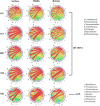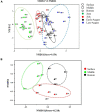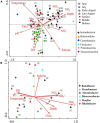Understanding the Variation of Bacteria in Response to Summertime Oxygen Depletion in Water Column of Bohai Sea
- PMID: 35756048
- PMCID: PMC9221365
- DOI: 10.3389/fmicb.2022.890973
Understanding the Variation of Bacteria in Response to Summertime Oxygen Depletion in Water Column of Bohai Sea
Abstract
Aiming to reveal the variation in bacteria community under oxygen depletion formed every summer in water column of central Bohai Sea, a time-scenario sampling from June to August in 2018 at a 20-day interval along one inshore-offshore transect was settled. Water samples were collected at the surface, middle, and bottom layer and then analyzed by high-throughput sequencing targeting both 16S rRNA and nosZ genes. Compared to the surface and middle water, oxygen depletion occurred at bottom layer in August. In top two layers, Cyanobacteria dominated the bacterial community, whereas heterotrophic bacteria became dominant in bottom water of Bohai Sea. Based on the time scenario, distinct community separation was observed before (June and July) and after (August) oxygen depletion (p = 0.003). Vertically, strict stratification of nosZ gene was stably formed along 3 sampling layers. As a response to oxygen depletion, the diversity indices of both total bacteria (16S rRNA) and nosZ gene-encoded denitrification bacteria all increased, which indicated the intense potential of nitrogen lose when oxygen depleted. Dissolved oxygen (DO) was the key impacting factor on the community composition of total bacteria in June, whereas nutrients together with DO play the important roles in August for both total and denitrifying bacteria. The biotic impact was revealed further by strong correlations which showed between Cyanobacteria and heterotrophic bacteria in June from co-occurrence network analysis, which became weak in August when DO was depleted. This study discovered the variation in bacteria community in oxygen-depleted water with further effort to understand the potential role of denitrifying bacteria under oxygen depletion in Bohai Sea for the first time, which provided insights into the microbial response to the world-wide expanding oxygen depletion and their contributions in the ocean nitrogen cycling.
Keywords: 16S rRNA; Bohai Sea; bacteria; community variation; nosZ gene; oxygen depletion.
Copyright © 2022 Wang, Guo, Li, Song and Zhao.
Conflict of interest statement
The authors declare that the research was conducted in the absence of any commercial or financial relationships that could be construed as a potential conflict of interest.
Figures









Similar articles
-
Adaptation of Archaeal Communities to Summer Hypoxia in the Sediment of Bohai Sea.Ecol Evol. 2025 Jan 8;15(1):e70768. doi: 10.1002/ece3.70768. eCollection 2025 Jan. Ecol Evol. 2025. PMID: 39781248 Free PMC article.
-
[Distribution Characteristics of Chromophoric Dissolved Organic Matter and Nutrients from the Yellow Sea and Bohai Sea in Autumn].Huan Jing Ke Xue. 2017 Nov 8;38(11):4501-4512. doi: 10.13227/j.hjkx.201703183. Huan Jing Ke Xue. 2017. PMID: 29965393 Chinese.
-
Effects of environmental factors on denitrifying bacteria and functional genes in sediments of Bohai Sea, China.Mar Pollut Bull. 2020 Nov;160:111621. doi: 10.1016/j.marpolbul.2020.111621. Epub 2020 Sep 9. Mar Pollut Bull. 2020. PMID: 32919123
-
Strong Seasonality in Arctic Estuarine Microbial Food Webs.Front Microbiol. 2019 Nov 29;10:2628. doi: 10.3389/fmicb.2019.02628. eCollection 2019. Front Microbiol. 2019. PMID: 31849850 Free PMC article. Review.
-
Seasonal oxygen depletion in the North Sea, a review.Mar Pollut Bull. 2015 Oct 15;99(1-2):5-27. doi: 10.1016/j.marpolbul.2015.06.021. Epub 2015 Jul 30. Mar Pollut Bull. 2015. PMID: 26234616 Review.
Cited by
-
Adaptation of Archaeal Communities to Summer Hypoxia in the Sediment of Bohai Sea.Ecol Evol. 2025 Jan 8;15(1):e70768. doi: 10.1002/ece3.70768. eCollection 2025 Jan. Ecol Evol. 2025. PMID: 39781248 Free PMC article.
-
Bacterial taxonomic and functional profiles from Bohai Sea to northern Yellow Sea.Front Microbiol. 2023 Feb 23;14:1139950. doi: 10.3389/fmicb.2023.1139950. eCollection 2023. Front Microbiol. 2023. PMID: 36910186 Free PMC article.
References
-
- Aldunate M., De la Iglesia R., Bertagnolli A. D., Ulloa O. (2018). Oxygen modulates bacterial community composition in the coastal upwelling waters off central Chile. Deep Sea Res. 2 Top Stud. Oceanogr. 156 68–79.
-
- Alonso-Gutiérrez J., Figueras A., Albaigés J., Jiménez N., Vinas M., Solanas A. M., et al. (2009). Bacterial communities from shoreline environments (Costa da Morte. Northwestern Spain) affected by the Prestige oil spill. Appl. Environ. Microbiol. 75 3407–3418. 10.1128/AEM.01776-08 - DOI - PMC - PubMed
-
- Arevalo-Martínez D. L., Kock A., Schmitz R. A., Bange H. W. (2015). Massive nitrous oxide emissions from the tropical South Pacific Ocean. Nat. Geosci. 8 530–533.
LinkOut - more resources
Full Text Sources
Research Materials

